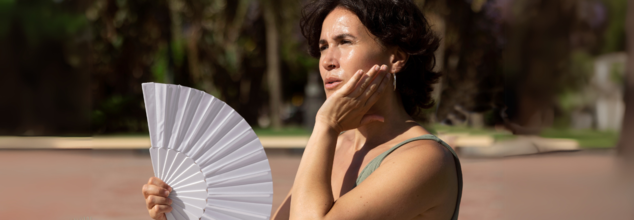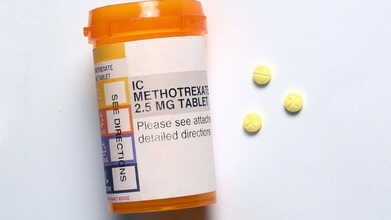- Health Conditions A-Z
- Health & Wellness
- Nutrition
- Fitness
- Health News
- Ayurveda
- Videos
- Medicine A-Z
- Parenting
Heat Waves Might Be A Fast-Forward Button On Your Ageing

Credits: Canva
As extreme temperatures rise globally, a silent danger is building—and it could be accelerating how rapidly we get older. Beyond the evident destruction of heat exhaustion, dehydration, and stress brought on by the climate, science is beginning to discover deeper, less evident harm: heat waves could be speeding up cellular aging.
With historic highs in global temperatures and rising frequency of heatwaves, particularly in the U.S. and Asia, scientists are calling for consideration at the nexus of environmental heat and epigenetic ageing.
What is Epigenetic Age?
Chronological age is the age on your driver's license, but epigenetic age is the age written far down in your cells. This scientific term tracks how old your body is biologically, based on chemical alterations in your DNA. These alterations, referred to as DNA methylation, function like switches that flip genes on and off. As we get older, these patterns change—and scientists use them to approximate biological age with instruments referred to as "epigenetic clocks."
Your epigenetic age doesn’t always match your chronological one. Influences like pollution, stress, poor lifestyle habits, and now—heat exposure—can accelerate epigenetic aging. This internal ticking clock impacts everything from how quickly your skin ages to your ability to fight disease, recover from illness, or manage inflammation.
Is Your DNA A New Risk Factor?
In 2023, a new German study published in Environment International found a strong association between heat exposure and epigenetic age acceleration. Scientists discovered that in areas where average annual temperatures were only 1°C higher, individuals exhibited evidence of accelerated biological aging.
Wenli Ni, a Harvard T.H. Chan School of Public Health postdoctoral research fellow and first author of the study, explained that heat stress affects DNA methylation patterns. These alterations can compromise gene function, accelerate aging, and cause a cascade of biological damage—particularly if the exposure is chronic.
Additionally, Taiwan studies that had more than 2,000 participants upheld the association. The increase in biological age was attributed to a rise of 1°C from the average of 180 days by 0.04 to 0.08 years. At first, it might appear negligible in the short term, but when consistent throughout years and population, it aids in premature occurrence of diseases that are related to age and makes healthcare burdens worse on a worldwide scale.
Why The Heat in 2024 Was a Tipping Point?
2024 was the hottest year ever, with almost 6.8 billion individuals facing record-breaking heat for a minimum of a month. Health professionals in areas such as India observed an influx of patients who looked physically older than their age, which sent alarm signals regarding the influence of climate on the health and lifespan of human beings.
One such U.S.-based study, published in Science Advances, looked at more than 3,500 adults older than age 56 and discovered a robust association between prolonged heat exposure (1–6 years) and cellular aging. Chronic heat not only disturbed sleep and increased levels of stress, but also played a role in biological deterioration that grew more severe with time.
The German study also emphasized that women, and especially those with Type 2 diabetes or obesity, showed stronger links between heat and increased aging. Women produce less sweat and their bodies generally take longer to trigger cooling, placing them at a physiological disadvantage during heatwaves.
Diabetics and the obese also have difficulty with heat dissipation because of decreased blood flow and insulating body fat, which complicates the release of heat from the core to the skin. These conditions further enhance the biological effect of heat, raising the risk of cardiovascular issues, kidney injury, and premature chronic diseases.
Epigenetic Impact Before Birth
Unsettlingly, even the effect of heat and climatic stress may start pre-natally. A recent research study, conducted on Kenya-based drought-stricken mothers who published their paper in Nature, suggested that intra-uterine exposure to harsh external environmental conditions contributed to hastened aging of their children.
Stress during pregnancy, water deprivation, caloric deficit, and psychogenic stress induced epigenetic changes in fetuses under development—showing that ageing might be modifiable by external surroundings even before one's life is started. All this indicates towards a dire requirement of addressing determinants of well-being, including access to nutrition, water, and gender balance, especially among climate-risk districts.
Ways to Protect Against Heat-Related Ageing
While reversing climate change will take systemic global action, individuals can take key steps to protect themselves from heat-induced aging:
1. Stay Hydrated
Dehydration is one of the most immediate risks of extreme heat. Drink water frequently—don’t wait until you’re thirsty. Carry water when heading outdoors and avoid alcohol and caffeine in hot weather.
2. Keep Cool
Use air conditioning when possible. If it’s not available, electric fans can offer relief when the indoor temperature is below 104°F (40°C). Keep your skin damp with a wet towel, mist bottle, or sponge baths. Visit air-conditioned public spaces like malls or libraries.
3. Dress Smart
Wear light-colored, breathable clothing. Avoid tight fabrics. Use wide-brimmed hats and sunscreen to protect your skin from direct sun exposure.
4. Plan Smartly
Avoid hard work between 11 a.m. and 4 p.m., the usual peak heat period. Schedule chores in the morning or evening when it's cooler.
5. Check In With At-Risk People
The most susceptible are older people, young children, pregnant women, and those with serious illness. Make sure they avoid heat and drink plenty of water when a heatwave hits.
The connection between climate and aging is no longer conjecture—it's quantifiable and based on several worldwide studies. As heat waves and frigid days become the norm, public health infrastructure needs to change by not only addressing heat as a weather phenomenon, but as a constant health threat.
Long-term solutions will require more than individual behavior. Governments and health institutions will have to prioritize heat preparedness plans, enhance urban infrastructure, and establish cooling centers. Policies specifically targeting enhancement of food security, safeguarding pregnant women, and mitigating occupational exposure to heat—particularly among women in labor-intensive occupations will be crucial.
In conclusion, if we don't take action to stem the increasing menace of heat extremes, we are likely to wind the clock forward—not only on climate, but on the human life expectancy as well. To age more quickly as a result of exposure to the environment is a brewing public health emergency and the world needs to wake up to it.
Omeprazole Alternative? Experts Point To A Kitchen Spice That May Ease Acid Reflux

Credits: Canva
A doctor has highlighted a common kitchen spice that may work just as effectively as omeprazole in relieving heartburn, acid reflux, and indigestion. Omeprazole is often prescribed for these conditions as a Proton Pump Inhibitor (PPI), helping to reduce the amount of acid produced in the stomach.
About 15% of the UK population takes a PPI like omeprazole. In England alone, over 73 million PPI prescriptions were issued in 2022–23, with omeprazole among the most commonly prescribed.
What Is Omeprazole Used For?
Omeprazole is a drug that lowers the amount of acid the stomach produces. Part of a class of medicines called proton pump inhibitors (PPIs), it is used to treat and prevent a range of acid-related problems, as per Mayo Clinic.
The length of treatment with omeprazole, as advised by your doctor, depends on the condition being treated and the prescribed dosage. Following your healthcare provider’s instructions and completing the full course of medication, even if symptoms improve, is important.
However, long-term use of omeprazole can increase the risk of various health issues, making regular consultations with your GP important, reports the Mirror. Prolonged acid suppression and changes in gut bacteria caused by extended use can result in several complications.
Lower stomach acid can reduce the body’s ability to absorb key nutrients, potentially causing deficiencies in magnesium, vitamin B12, calcium, and iron. Long-term use may also raise the risk of bone fractures and kidney problems. Other possible issues include growths in the stomach, dementia, and liver or heart problems.
Suppressing stomach acid, which normally kills harmful bacteria, can make the body more prone to infections such as community-acquired pneumonia or Clostridioides difficile infection, which causes severe diarrhoea and stomach pain.
Omeprazole Alternative: What Is The Spice, And How Can It Help?
Experts suggest that one kitchen spice could match omeprazole’s effectiveness while avoiding its health risks. Dr Michael Ruscio, DC, DNM, says curcumin, the active compound in turmeric, may be “just as effective,” according to research.
Dr Ruscio, a naturopathic practitioner, clinical researcher, and author, has published work in peer-reviewed medical journals. He is the Chief Health Officer and Head of Research at RIFM, and Founder and CEO of DrRuscio.com.
In a YouTube video for his 145k subscribers, Dr Ruscio explained that curcumin may help manage heartburn and acid reflux without relying on PPIs. He said: “Let me show you an important study demonstrating the power of anti-inflammatory interventions. You’ve probably heard of curcumin, this anti-inflammatory spice. A 2023 randomized control trial compared omeprazole to curcumin at two grams per day for one month.”
Quoting the study, “Curcumin and omeprazole showed similar effectiveness for functional dyspepsia,” a term covering symptoms like fullness, GORD, and indigestion. Dr Ruscio added, “It’s remarkable that curcumin, which also has benefits such as reducing joint pain, can be as effective as omeprazole. And it doesn’t carry the long-term risks of acid suppression that come with omeprazole.”
Curcumin’s anti-inflammatory and antioxidant properties may reduce oesophageal inflammation caused by stomach acid. Animal studies suggest it can protect the stomach lining from damage caused by certain medications and other irritants.
What Did The Study's Findings Reveal?
The referenced research, published in BMJ Journals as “Curcumin and proton pump inhibitors for functional dyspepsia: a randomized, double-blind controlled trial,” found that a daily dose of curcumin provided relief from functional dyspepsia symptoms comparable to omeprazole.
No significant side effects were observed, though liver function tests showed some decline in overweight participants taking curcumin. The researchers noted limitations including the short study period and lack of long-term data.
They concluded, “This multicentre randomized controlled trial provides strong evidence for treating functional dyspepsia.”
Functional dyspepsia, or chronic indigestion, occurs as persistent or recurring discomfort in the upper abdomen. Symptoms may include bloating, burping, nausea, or feeling full too quickly, often signaling issues in the oesophagus, stomach, or duodenum.
Despite promising results, it is essential to consult your doctor before making major changes to your diet or replacing prescribed medication with supplements. A discussion with your GP can help identify the most effective approach to managing your health.
What Else Is Curcumin Good For?
Curcumin is a powerful antioxidant that neutralizes free radicals, which can damage cells and contribute to ageing and illnesses like heart disease and cancer. Studies suggest it may relieve symptoms of osteoarthritis and rheumatoid arthritis, easing joint pain, stiffness, and inflammation.
Some research indicates curcumin may be as effective as certain nonsteroidal anti-inflammatory drugs (NSAIDs) for pain relief.
It may also support brain health by raising levels of brain-derived neurotrophic factor (BDNF), a hormone important for memory and learning. Researchers are investigating its potential to protect cognitive function with age and against conditions like Alzheimer’s.
Additionally, curcumin’s anti-inflammatory and antioxidant effects, along with possible benefits for cholesterol and blood pressure, may reduce the risk of heart disease.
Taking Methotrexate For Arthritis? Doctors Explain The Risks Behind The Latest Warning

Credits: Canva
People who take methotrexate for different health conditions have been cautioned by the NHS that certain symptoms and side effects should not be ignored and may require urgent medical help, including a visit to A&E or calling 999. Methotrexate works as an immunosuppressant, meaning it dampens the immune system to help control inflammation in the body.
What Is Methotrexate?
Methotrexate belongs to a group of medicines known as antimetabolites. It helps manage rheumatoid arthritis by dampening the body’s immune response, controls psoriasis by slowing the rapid buildup of skin cells, and is used in cancer treatment to limit the growth and spread of cancer cells, as per Mayo Clinic.
Doctors commonly prescribe it for conditions such as rheumatoid arthritis, Crohn’s disease, and psoriasis. In some situations, it is also used as part of cancer treatment. Methotrexate is usually taken as a tablet, a liquid medicine that is swallowed, or as a pre-filled pen or syringe that is injected under the skin. While many people benefit from the drug, it can also cause serious side effects that may be worrying for some patients.
Side Effects Of Methotrexate And When To Call For Emergency?
Certain severe side effects linked to methotrexate are rare and affect fewer than 1 in 10,000 people. Even so, the NHS advises contacting your doctor or calling 111 if you notice any of the following symptoms:
- Swelling in the hands, feet, or ankles along with shortness of breath, which may point to a kidney issue
- A long-lasting cough, chest discomfort, or trouble breathing, which could suggest lung inflammation
- Yellowing of the skin or the whites of the eyes, which can indicate liver damage
- Bleeding gums, vomiting blood, unexplained bruises, or blood in the urine, which may signal a blood disorder
- A high temperature, sore throat, or body aches, which could be signs of an infection
Symptoms of this can include:
- Swelling of the lips, throat, or tongue
- A tight sensation in the throat or difficulty swallowing
- Confusion
- Collapsing or fainting and being hard to wake
- Skin, lips, or tongue turning blue, pale, or grey
- Very rapid breathing or severe difficulty breathing
Methotrexate: What Should You Watch Out For While Taking This Medication?
See your care team regularly so they can monitor how the treatment is working. It may take a while before you notice any improvement. You may be asked to get routine blood tests during the course of treatment.
If your care team has prescribed folic acid along with methotrexate, they may advise you not to take folic acid on the same day as your methotrexate dose.
This medicine can make your skin more sensitive to sunlight. Try to stay out of direct sun exposure. If that is not possible, wear covered clothing and apply sunscreen. Avoid sun lamps, tanning beds, or tanning booths.
Contact your care team if you have severe diarrhea, ongoing nausea or vomiting, or heavy sweating. Losing too much fluid from your body can make this medicine unsafe. This drug can raise your chances of developing an infection. Call your care team if you develop a fever, chills, sore throat, or flu-like symptoms. Do not self-medicate. As far as possible, stay away from people who are unwell.
Discuss your cancer risk with your care team. Long-term use of this medication may increase the risk of certain cancers.
Speak to your care team if you or your partner could become pregnant. Methotrexate can cause serious birth defects if taken during pregnancy or within six months after the last dose. A negative pregnancy test is required before starting treatment. Reliable contraception should be used while on this medication and for six months after stopping it. Your care team can guide you on suitable options.
If your partner can become pregnant, use condoms during sexual activity while taking this medication and for three months after the final dose. Do not breastfeed while using this medication and for at least one week after the last dose.
This medication may affect fertility. If this is a concern, discuss it with your care team.
Bemotrizinol: FDA Proposes New Sunscreen Ingredient—Here’s Why It Matters

Credits: Canva
America is aiming to align with global trends in sun protection. On December 11, the Food and Drug Administration proposed allowing the use of bemotrizinol in sunscreens — an ingredient that has been widely used in other countries for years.
Bemotrizinol provides stable, long-lasting defence against both types of UV rays that can harm the skin. According to the FDA announcement, it is gentle enough to be safe for young children and could be on shelves in time for next summer.
"The agency has historically moved too slowly in this area, leaving Americans with fewer options than consumers abroad. We’re continuing to modernize the regulation of sunscreen and other over-the-counter drug products,” FDA Commissioner Marty Makary said in a press statement. “Americans deserve timely access to the best safe, effective, and consumer-friendly over-the-counter products available.”
What is Bemotrizinol?
Bemotrizinol, also called BEMT, is a chemical that absorbs both UVB and UVA rays. If those terms sound familiar, it’s likely because you’ve seen them on nearly every sunscreen bottle. The sun emits ultraviolet (UV) radiation, which is exactly what sunscreen is designed to block.
UVB and UVA describe different kinds of rays, according to the University of Texas MD Anderson Cancer Center. For our skin, the difference isn’t huge. UVA causes tanning and burns faster than UVB, while UVB can be partially blocked by barriers like windows or clouds.
About 95% of UV reaching the ground is UVA, with UVB making up the remaining 5%, according to the Anderson Cancer Center. Sunscreens work in two ways: creating a physical barrier with minerals or using chemicals that absorb rays before they reach the skin. BEMT falls into the latter category.
Why Is BEMT Good For Use In Sunscreen?
BEMT ticks many boxes for an effective sunscreen ingredient. It is broad-spectrum, shielding against both UVA and UVB, and achieves higher SPF protection in smaller amounts than some other popular chemicals, according to Certified Laboratories and the FDA via USA Today. It is also photostable, meaning it breaks down more slowly when exposed to sunlight, and being oil-soluble makes it easy to mix into creams.
The ingredient is minimally absorbed into the body through the skin and rarely causes irritation, which is why the FDA considers it safe for children as young as six months old.
When Will BEMT Come To Sunscreen In The US?
Following the proposal, the FDA has opened a 45-day public comment period. Once the agency reviews feedback and confirms safety, it will issue a final order to allow the ingredient. Over-the-counter approvals are generally faster than the one-to-two years typical for prescription drugs. The FDA told Today that BEMT sunscreens could be available by summer or fall of 2026.
What Caused FDA Delays in Sunscreen Approvals?
Recent holdups at the U.S. Food and Drug Administration in clearing new sunscreen ingredients have largely stemmed from long-standing regulatory slowdowns, which left American shoppers with fewer choices than those offered in many other countries.
The agency’s plan to permit the use of bemotrizinol, a filter already common abroad, marks a step toward updating its approach to sunscreen oversight and giving people access to more advanced formulas. Updates from the agency note that bemotrizinol delivers steady, broad-spectrum defense against UVA and UVB rays and is mild enough for children, bringing U.S. standards closer to what is widely available worldwide.
© 2024 Bennett, Coleman & Company Limited

